The battle between white hat and black hat SEO strategies is high-stakes, and the stakes are your website’s visibility and credibility.
Since Google processes 8.5 searches daily [1], such immense traffic requires you to up your game if you want to secure a spot on the first page of search results.
One strategy promises quick results but comes with significant risks, while the other demands patience but offers sustainable growth and success.
However, here’s the catch: employing the wrong SEO tactics could get your website penalized or even banned from Google altogether.
Which one do you choose?
Our blog, which compares white hat vs black hat SEO strategies, will give you all the answers you need.
White Hat vs Black Hat SEO: Overview
White hat vs black hat SEO are terms derived from Western movies where the hero (white hat) follows the law, and the villain (black hat) breaks it. Similarly, in SEO, white hat techniques align with the search engine guidelines, while black hat methods break those rules in pursuit of quick gains.
What is White Hat SEO?
White hat SEO focuses on long-term success by improving user experience and delivering valuable content.
These techniques include keyword research, quality content creation, on-page optimization, and ethical link building services. If your website follows white hat SEO strategies, you are more likely to see sustained rankings and avoid penalties.
You have to use optimization strategies, techniques, and tactics that focus on a human audience rather than search engines and completely adhere to search engine rules and policies.
This white hat approach will improve your website’s search engine rankings and maintain integrity and credibility in the eyes of your audience.
If you’re wondering will SEO work for your business, understanding which strategies to employ is the first step.
What is Black Hat SEO?
Black hat SEO definition refers to practices and strategies used to increase a website’s ranking in search engine results through means that violate search engine guidelines. It involves deceptive practices that manipulate search engine algorithms.
These techniques might yield quick results but at the risk of severe penalties.
Common black hat tactics include keyword stuffing, cloaking, and using private link networks. While they might provide a temporary boost, the long-term consequences are devastating, including being blacklisted by Google.
Black Hat vs. White Hat SEO: Main Differences
Both black hat and white hat SEO have the same goal: to improve your search engine rankings. What distinguishes them are their approach and long-term impacts.
It’s important to understand that both strategies cover all aspects of SEO—on-page, off-page, technical, and content SEO. White hat SEO is the right way to approach all these aspects, while black hat will nullify your traffic in the long run and can even penalize your website.
| White Hat SEO | Black Hat SEO | |
| Ethics and Compliance | Adheres to search engine guidelines and focuses on providing value to users. It aims for sustainable growth by enhancing user experience, creating quality content, and earning legitimate backlinks. | Violates search engine rules by using manipulative tactics to achieve quick results. These techniques often deceive both users and search engines, risking severe penalties. |
| Longevity of Results | Builds a solid foundation for long-term success. By following ethical practices, websites can maintain and improve their rankings over time without fear of penalties. | May offer short-term gains but carries the risk of significant setbacks. Search engines frequently update their algorithms to detect and penalize black hat tactics, leading to potential loss of rankings and traffic. |
| User Experience | Prioritizes user experience by providing valuable, relevant content and ensuring website accessibility and usability. This approach not only satisfies search engine algorithms but also builds trust and loyalty among users. | Often sacrifices user experience for quick wins. Techniques like keyword stuffing and hidden text can make content less readable and engaging, ultimately driving users away. |
| Risk of Penalties | Operates within the safety of search engine guidelines, reducing the risk of penalties. Websites that employ these tactics are more likely to enjoy stable, long-term rankings. | Exposes websites to significant risks. Search engines like Google actively seek out and penalize websites using black hat methods, which can result in drastic drops in rankings or complete removal from search results. |
7 White Hat SEO Techniques To Use for Higher Rankings
If you want long-term and sustainable SEO growth, you need to employ white hat SEO techniques. Lucky for you, we’ve prepared some of the best that will work in 2025, having taken into consideration the latest Google Algorithm updates.
1. Quality Content Creation
We can’t talk about SEO without mentioning the best white hat strategy—quality content. It involves producing content that is not only valuable and relevant but also engaging for your target audience. Google’s updates, especially the recent core ones, heavily favor high-quality content.
For example, a SaaS company can create a comprehensive guide on “Choosing the Right CRM Software,” including detailed comparisons, user reviews, and case studies. This type of content is informative, engaging, and provides real value to users.
The recent Google March Core update [2] specifically tackles spammy, low-quality content on Search. It all started in 2022 with the goal of reducing unhelpful, unoriginal content on Search and keeping it at very low levels.
![Screenshot from Google’s official perspective and March Core Update [2].](https://nuoptima.com/wp-content/uploads/2022/05/Screenshot-from-Googles-official-perspective-and-March-Core-Update.png)
Black hat techniques like scaled content and site reputation abuse are primary targets for this update, and Google focuses on reducing the manipulation of search rankings with these algorithm updates. Another target is low-value AI content that many websites abused in hopes of scaling their content production. But with SEO, shortcuts usually don’t work long-term, so it’s best to steer clear AI content.
2. Keyword Research
If you want your target audience to discover your content and you want to publish relevant content, keyword research and optimization are a must. Keyword research involves identifying and analyzing specific terms and phrases that people use in search engines to find relevant information, products, or services.
So, you have to identify the terms and phrases your target audience is searching for and optimize your content to include these keywords naturally.
Using tools like Ahrefs or Semush, you can discover relevant search terms and see how many monthly searches (monthly search volume) it has and how hard it is to rank for it (keyword difficulty).
For example, if you run a health blog, you can type in relevant terms in Ahrefs or Semrush, such as “benefits of intermittent fasting,” and then create a detailed article that addresses this topic, including scientifically backed information and personal anecdotes.
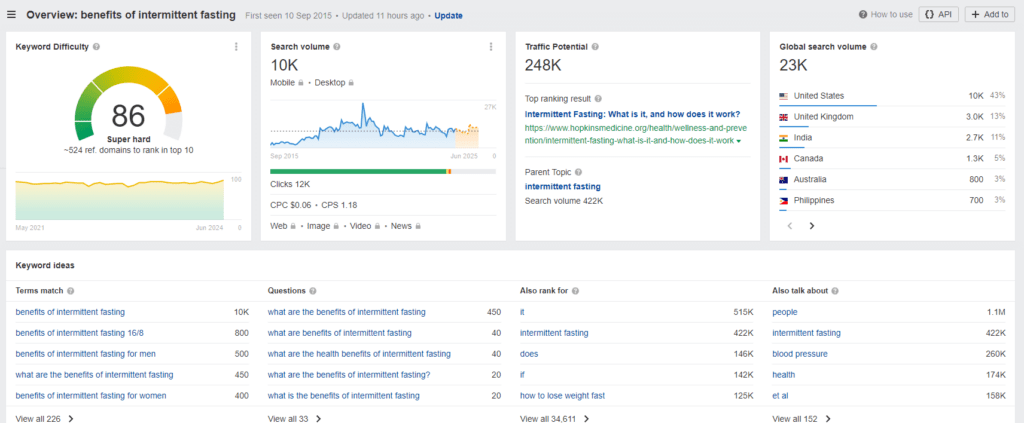
Remember that Google has become better and better at understanding the meaning behind search queries, and focuses on semantic search and related keywords rather than just exact match keywords.
If you need content ideas, you can just type in your broad keyword, and tools like Semrush will give you recommendations for topics you can cover.
For example, for “custom t shirts”, you can see that people are asking “how to make custom t shirts” and “where to get custom t shirts” which are all topics you can cover on your website.
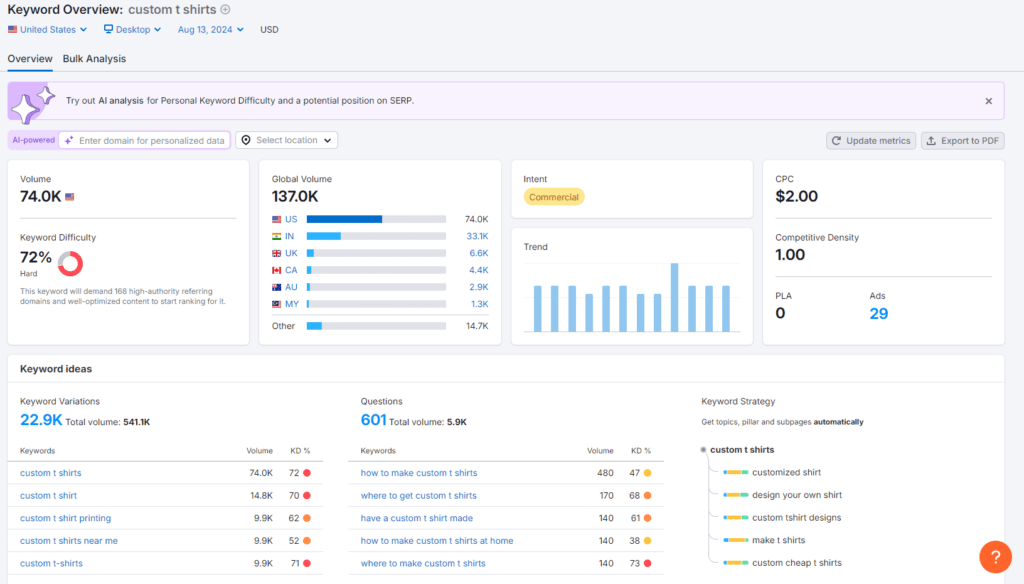
3. On-Page SEO
Google is all about user experience. And on-page SEO is all about optimizing various elements of your web pages and posts to improve user experience. These elements include not only header tags, meta descriptions, and title tags but also URL structure, internal linking, image optimization, and content quality.
When done correctly, on-page SEO makes it easier for Google and readers to understand your content, navigate your site, and find the information they’re looking for. It’s about aligning your content with search intent, making sure that every page provides value, and guiding users easily through your website.
For example, in a travel blog, the content should be organized in a way that’s easy to follow, with clear headings that reflect the structure of the article. The use of relevant keywords should be natural and strategically placed in the title tag, meta description, headings, and throughout the content itself. Additionally, the URL structure should be clean and descriptive, helping both users and search engines understand what the page is about at a glance.
Let’s say you have an article titled “Top 10 Destinations in Europe.” The title tag could be “Top 10 Destinations in Europe – Best Places to Visit in 2025,” while the meta description could briefly summarize what readers can expect from the article. The images accompanying the post should have alt text that not only describes the image but also includes relevant keywords, such as “Eiffel Tower at sunset in Paris,” to help search engines index the images appropriately.
Moreover, on-page SEO extends to content quality itself—creating engaging, well-researched, and informative articles that satisfy user intent. By interlinking related articles within your site, you can also keep users engaged longer, reducing bounce rates and increasing the likelihood of conversions.
Curious about how to outrank industry giants in SEO? Watch this insightful webinar where experts share actionable strategies and content playbooks that can help even the smallest players compete with the big names.
4. Mobile Optimization
With the majority of searches now coming from mobile devices, you need to take a mobile-first approach when designing your website if you want SEO success. The most important aspects of white hat SEO for mobile optimization are responsiveness and great user experience across devices.
If you, for example, have an online store, you need to make sure that your product pages look and function well on smartphones and tablets. To achieve that, use larger buttons, optimized images, and a mobile-friendly navigation menu.
The Mobile-First Indexing means Google predominantly uses the mobile version of the content for indexing and ranking. Websites that are not mobile-optimized risk losing visibility in search results.
And here is how to make sure your website is optimized for all devices:
- Use responsive web design techniques to ensure that your website adapts seamlessly to different screen sizes and orientations. This approach maintains a consistent look and functionality across devices.
- Optimize images, minimize HTTP requests, and leverage browser caching to improve page load speed.
- Prioritize the visibility and accessibility of important content and calls-to-action (CTAs) on mobile screens. Consider the hierarchy of information and ensure that it is easy to read and interact with on smaller devices.
- Design buttons, links, and navigation menus with touchscreen interaction in mind. Ensure that elements are large enough to tap easily without accidental clicks, and provide enough space between clickable elements.
- Simplify forms and input fields for mobile users by reducing the number of fields required and using input types optimized for mobile devices (e.g., number pads for numeric inputs).
5. Page Load Speed
As you’ve probably realized by now, Google favors the same things users do. And fast-loading pages are definitely one of the most important factors in user experience. Hence, Google wants you to optimize your page load speed if you want to rank high.
An optimal page speed is under three seconds, with Google recommending a target of 2.5 seconds or faster. When assessing your website’s speed with Google’s PageSpeed Insights, a score of 90 or above is deemed excellent. Scores between 50 and 89 indicate that there’s room for improvement, while a score below 50 is considered poor. [4]
You can check your page load speed using Google PageSpeed Insights and identify specific areas for improvement. As long as your results are in the green, you’re good. But if the results are low, you can compress images, minify CSS and JavaScript files, leverage browser caching, and limit the impact of third-party scripts by delaying them.
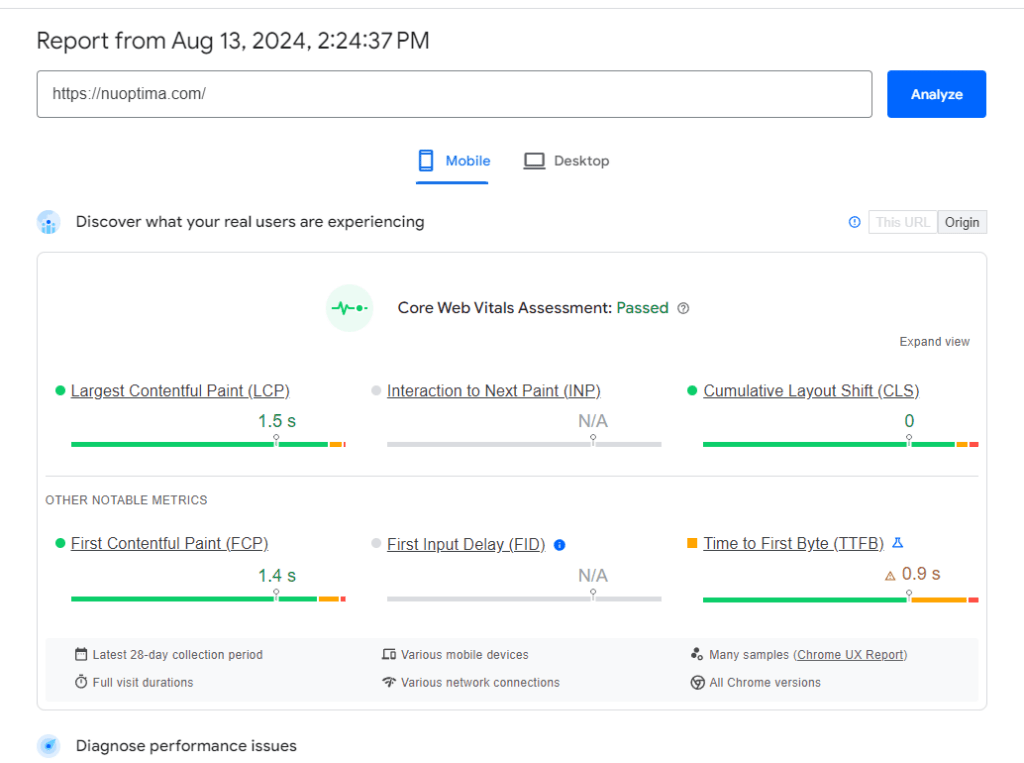
The Page Experience update, which includes Core Web Vitals, focuses on metrics like loading, interactivity, and visual stability. Websites that meet these performance metrics are more likely to rank higher.
The most important Core Web Vital metrics are:
- Largest Contentful Paint (LCP)
- Measures: Loading performance—how long it takes for the largest content element to load.
- Ideal Value: Less than 2.5 seconds.
- Improve by: Optimizing images, improving server response times, and minimizing JavaScript.
- First Input Delay (FID):
- Measures: Interactivity—how quickly the page responds to the first user interaction.
- Ideal Value: Less than 100 milliseconds.
- Improve by: Reducing JavaScript execution time and optimizing third-party scripts.
- Cumulative Layout Shift (CLS):
- Measures: Visual stability—how much the page layout shifts unexpectedly during loading.
- Ideal Value: Less than 0.1.
- Improve by: Reserving space for images, ads, and embeds to prevent layout shifts.
There are many differences between technical vs content SEO, but you have to keep in mind that they work together to bring you the desired results. For black hat vs white hat SEO, that’s not the case. You either do one or another!
6. Ethical Link Building
One of the greatest challenges of white hat SEO is link building. It’s easier to fall into black hat SEO techniques in this field because it can be hard to acquire high-quality backlinks from reputable websites if you’re just starting out.
Even if you have a well-established website, you still need to devote a lot of time to building and maintaining relationships with link-building partners. For SaaS companies, leveraging a specialized SaaS link building agency can help ensure your link-building strategy aligns with white hat principles while maximizing results in a competitive landscape.
When we say ethical link building, we mean guest blogging, creating linkable content, and building relationships with industry influencers.
You can create link-worthy content by producing valuable, informative, and engaging content that others will naturally want to link to. This could be in the form of in-depth guides, research studies, infographics, or unique data insights.
For example, HubSpot’s “State of Marketing” report generates more than 40k backlinks.

The Penguin update [3], now part of Google’s core algorithm, specifically targeted unnatural links generated by link purchase or rent from link farms.
7. Structured Data and Rich Snippets
For some search terms, it’s not enough to rank #1 and call it a day. That’s why many businesses “fight” to win rich results in SERPs. Those can be answers to “People Also Ask” or featured snippets that have a high click-through rate and boost credibility.
But how do you win these?
Using structured data markup, such as Schema.org, helps search engines understand the content on your pages and can lead to rich snippets, which enhance your listings in search results.
There are free tools that help you generate schema for your website, and there are also extensive guidelines by Google. [5]
One of the best tools is Schema Markup Generator, where you just add the information required for structured data, and it automatically creates a JSON code you can just copy and paste on your website.
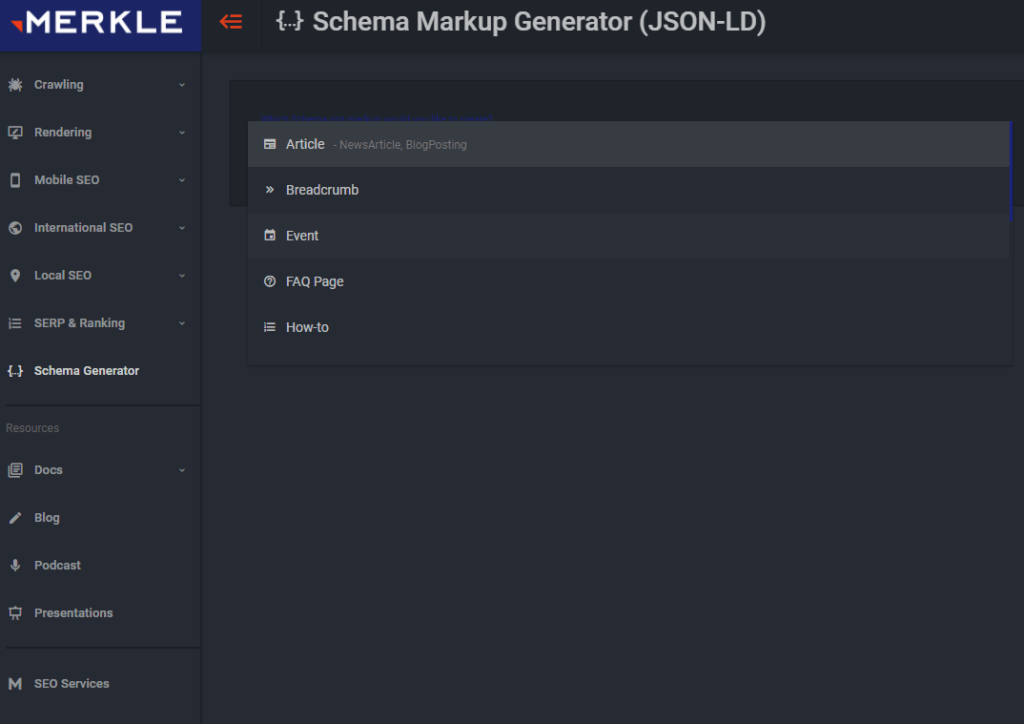
For example, an online recipe site can use structured data to mark up recipes, including ingredients, cooking time, and nutritional information. This can result in rich snippets that show these details directly in search results, increasing click-through rates.
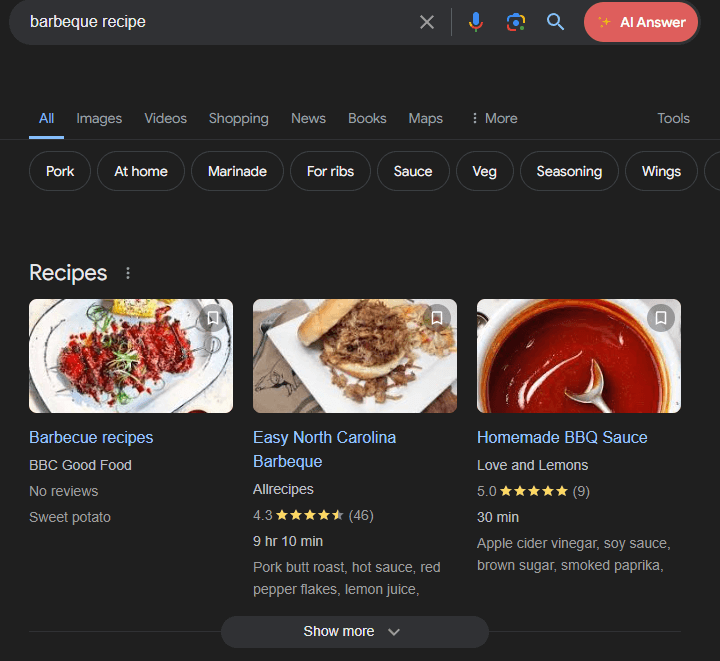
Black Hat SEO Techniques To Avoid
While black hat SEO techniques that promise quick and significant results are tempting, they also come with substantial risks that undermine your long-term success. We’ve taken some of the most popular ones and explained with examples how they can forever ruin your chances of ranking.
Keyword Stuffing
Keyword stuffing involves overloading a webpage with keywords in an attempt to manipulate a site’s ranking in search results. This practice can make the content unreadable and less valuable to users.
And what users don’t find valuable, neither does Google. Let’s see an example:
A travel website might repetitively use the phrase “cheap flights to Paris” in an unnatural manner:
“Are you looking for cheap flights to Paris? Our website offers the best deals on cheap flights to Paris. Find cheap flights to Paris with our easy-to-use search tool. Book your cheap flights to Paris today and save on cheap flights to Paris. Compare cheap flights to Paris from various airlines and choose the cheapest flights to Paris that suit your budget.”
Doesn’t sound good, does it?
Google’s algorithms, particularly the Panda update, target sites with poor-quality content, including those that engage in keyword stuffing. [6] This can result in lower rankings or even complete removal from search results.
Cloaking
Cloaking is a deceptive practice where a different version of a webpage is shown to search engines than to users. This misleads search engines about the content’s true nature.
A website might present a keyword-rich page to search engines while showing a completely different, often irrelevant, page to users.
When a search engine bot visits a webpage, the server identifies it based on its user-agent (a string of text that identifies the browser and operating system to the server). Cloaking techniques involve configuring the server to deliver one version of a webpage to search engine bots (optimized with keywords and other SEO elements) and a different version to regular users (which might contain less optimized or completely different content).
Note: Cloaking is considered a serious violation of Google’s Webmaster Guidelines. If you employ cloaking, you can expect:
- Manual actions
- Algorithmic penalties
- De-indexing
Hidden Text and Links
Hidden text and links are exactly what the name suggests—placing links or text invisible to users but readable by search engine bots. Webmasters usually do this with the goal of manipulating rankings by implementing links or keywords in an unnatural way.
But how do they do it?
By using white text on a white background and placing text behind images to include keywords or links without users seeing them.
Luckily for us who stay away from these black hat SEO strategies, Google’s algorithm successfully detects and penalizes such practices and usually results in a huge drop in rankings for websites that use it.
Link Farms
Link farms are a deceptive Black Hat SEO tactic where a network of websites is created solely for the purpose of linking to each other to manipulate search engine rankings. The idea behind link farms is to artificially inflate the number of backlinks pointing to a site, making it appear more authoritative to search engines like Google.
However, these links are often low-quality and irrelevant, and search engines have become adept at detecting and penalizing such manipulative practices.
Imagine you own a small business selling handmade candles online. You’ve heard that getting other websites to link to your site can improve your search engine rankings, so you’re tempted to take a shortcut. A dubious SEO service offers to quickly boost your site’s rankings by adding your website link to a network of 100 other sites. This network is essentially a link farm.
- The SEO service creates or has access to a large number of low-quality websites. These sites are often unrelated to your business and may contain generic or even spammy content.
- Your website’s link is placed on each of these sites, and in return, those sites link back to each other and possibly other clients’ sites as well.
- The result is a web of interconnected links that give the false impression of popularity and authority.
However, this is where the problem begins. Search engines like Google have algorithms specifically designed to detect unnatural link patterns and irrelevant links. When Google identifies a link farm, it devalues the links from those sites, and in many cases, penalizes the sites involved by lowering their rankings or removing them from search results altogether.
The Penguin update we’ve already mentioned targets unnatural link patterns and penalizes sites involved in link farming. This can lead to a severe decline in search rankings and loss of credibility.
Duplicate Content
Duplicate content involves copying content from other websites or duplicating your own content across multiple pages, misleading search engines into thinking the site is more authoritative.
There are two types of duplicate content:
- Internal Duplicate Content: Occurs within a single website when multiple URLs serve the same or very similar content. This can happen due to URL parameters, session IDs, printer-friendly versions, etc.
- External Duplicate Content: Involves identical or nearly identical content that appears on different websites across the internet. This may occur due to content scraping, syndication without proper canonicalization, or content distribution agreements.
Search engines may struggle to determine which version of the content to index and rank. This can lead to diluted rankings for the original content or even penalties if considered manipulative.
For example, a news website might copy entire articles from other sources and publish them as their own.
Google completely devalues sites with duplicate content.
Private Blog Networks (PBNs)
PBNs are a collection of websites used to build backlinks to a single website, manipulating search engine rankings, similar to link farms. Using PBNs can lead to severe penalties, including de-indexing all the sites involved.
Buying Old, Expired Domains
Buying old, expired domains as a black hat SEO strategy consists of purchasing and repurposing expired domains with the primary intention of boosting the search ranking of low-quality or unoriginal content.
In a White Hat SEO context, buying an expired domain can be a strategic move to:
- Rebrand a website
If the expired domain is relevant to your business or industry, it can be repurposed to create a new website or redirect traffic to an existing site.
- Capture existing traffic
Some expired domains still receive traffic from their previous users. Purchasing such a domain can help capture this traffic, especially if it is relevant to your current business.
- Build authority
If the expired domain has a strong backlink profile from reputable sources, it can be a valuable asset for enhancing your site’s authority.
Black Hat SEO practitioners exploit this by acquiring domains that previously had high authority and a high number of backlinks. They then repurpose these domains to host low-quality or spammy content, hoping to benefit from the existing authority and backlinks to improve their search rankings.
To combat this, Google’s March 2024 Core Update specifically targeted and devalued links from expired domains repurposed for SEO manipulation.
The misuse of expired domains as a Black Hat SEO strategy typically involves the following manipulative practices:
- Creating Private Blog Network (PBN)
Expired domains are often used in the creation of Private Blog Networks (PBNs). PBNs are networks of websites, each on a different expired domain, that exist solely to link to a central “money site” to artificially inflate its ranking.
- Deceptive redirects
Another Black Hat technique involves purchasing an expired domain with high traffic or a strong backlink profile and redirecting it to a completely unrelated site.
- Spamming with irrelevant content
After acquiring an expired domain, some Black Hat SEOs flood it with irrelevant or low-quality content stuffed with keywords in an attempt to rank for various search terms quickly.
How Does Google Punish Black Hat SEO Techniques?
From a drop in rankings to complete removal from search engine index, Google has various ways to detect and punish black hat SEO techniques. Some of the most common issues you’ll encounter if you don’t stay away from them are:
Manual Actions
Manual actions occur when a Google reviewer manually penalizes a site for violating Google’s Webmaster Guidelines. There are many circumstances that can prompt Google to give you a manual penalty, including reports by users or Google’s own investigation.
The problem is that manual actions are severe and long-term. You have to resolve the issues, which are often unclear, and ask Google to reconsider. It can take forever and you’ll lose traffic in revenue until (and if) it resolves.
Penalties
Google algorithm updates such as Panda, Penguin and various core updates like March one automatically detect and penalize sites using black hat SEO.
Algorithmic penalties can be difficult to diagnose and recover from. Site owners must identify and fix the issues, often involving changes to their SEO strategy and content.
And the thing with SEO is that it works best when you do it correctly from the start.
Types of penalties you can expect if you employ these black hat techniques:
- Algorithmic penalties
Algorithmic penalties are automatically applied by Google’s algorithms when they detect Black Hat SEO practices. These penalties are often the result of updates like Panda, Penguin, or core updates such as the March 2024 update.
For example:
- Sites with thin, duplicate, or low-quality content may see significant drops in rankings.
- Sites with manipulated backlink profiles may experience severe ranking declines.
- Manual actions
Manual actions are penalties applied by human reviewers at Google when they detect serious violations of Webmaster Guidelines. More severe infractions can lead to penalties that impact the entire website. This could result in significant ranking drops across all pages of the site.
De-Indexing
In severe cases, Google may completely remove a website from its search index. This means the site will not appear in any search results, effectively eliminating its organic search traffic.
De-indexing is one of the most severe penalties and can be devastating for a website’s traffic and credibility. Recovery, if possible, requires to go through a thorough cleanup of the site’s SEO practices and sending a reconsideration request to Google.
To check whether your website was deindexed, type site:yourwebsite.com into search and see if there are any results. If there are, your website wasn’t deindexed.
Why White Hat SEO Is the Way to Go?
Choosing white hat SEO strategies over black hat is a no-brainer for those who want to build sustainable and credible rankings. But what are the results you can expect?
Long-Term Results
While it may take longer to see gains, the outcomes of white hat SEO are stable and sustainable.
A blog that consistently publishes high-quality, informative articles on a specific niche will gradually build authority and attract a loyal audience. Over time, this leads to higher rankings and steady organic traffic.
User Experience
It’s all about your audience. White Hat SEO prioritizes user experience by creating valuable content, ensuring fast load times, and making websites easy to navigate. Improving user experience increases engagement, reduces bounce rates, and encourages repeat visits, all of which positively impact search engine rankings.
Avoiding Penalties
By adhering to ethical SEO practices, you avoid the risk of penalties that can result from Black hat techniques. Avoiding penalties means your site’s visibility and traffic remain stable, preventing sudden drops that can harm your business.
Compliance with Algorithm Updates
Google constantly updates its algorithm with a single goal in mind – to improve user experience and fight manipulative, black hat strategies. If you utilize white hat SEO techniques, you have nothing to worry about.
However, if you use black hat SEO to get quick results, every update will bring anxiety and stress until one finally hits your rankings.
If you’re uncertain about the right approach for your business, understanding how to choose an SEO agency will provide you with valuable insights and give you clarity regarding white hat SEO strategies you need.
Hire White Hat SEO Agency
White hat SEO doesn’t just require expertise but commitment to ethical practices that align with Google’s guidelines. At NUOPTIMA we specialize in white hat SEO strategies that deliver sustainable, long-term results to our clients.
Our approach focuses on creating high-quality content, optimizing user experience, and building legitimate backlinks that enhance your website’s authority and rankings. With NUOPTIMA, you can rest assured that your SEO strategy is in safe hands, free from the risks associated with Black Hat techniques.
Why Choose Nuoptima?
- We have a track record of helping businesses across industries achieve significant growth in organic traffic and search engine rankings.
- Our SEO plans are tailored to your business’s unique needs and goals, ensuring that every action we take is designed to maximize your return on investment.
- At NUOPTIMA, we adhere strictly to White Hat SEO practices, focusing on sustainable growth rather than shortcuts that could jeopardize your site’s future.
Let’s see what we’re talking about in action:
The Influencer Marketing Factory, a leading agency specializing in influencer marketing, faced challenges in scaling their SEO efforts to match their rapid business growth. They needed a partner who could help them improve their search engine rankings and attract more high-quality leads.
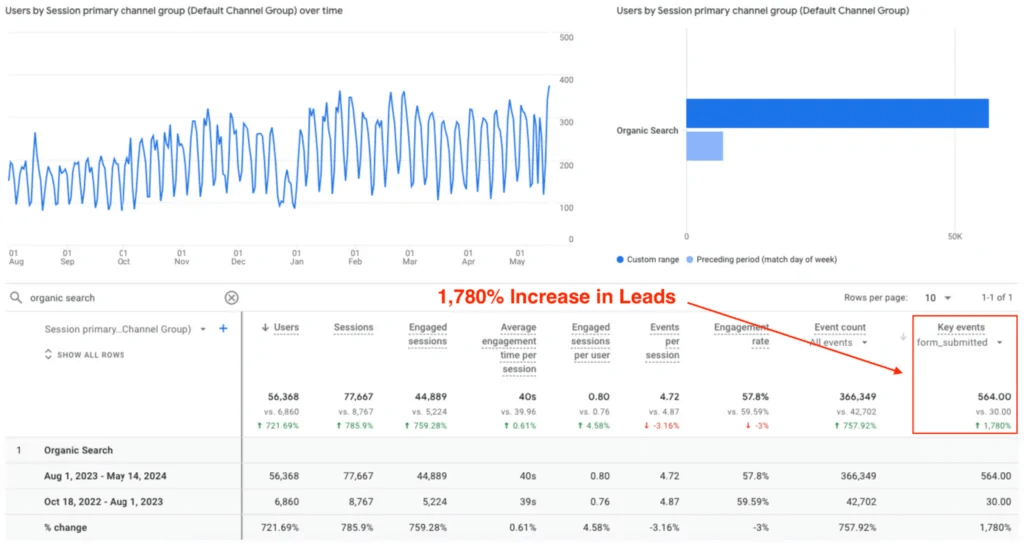
- Through strategic keyword targeting, content optimization, and technical SEO improvements, NUOPTIMA helped The Influencer Marketing Factory significantly increase their organic traffic by 96% within just 9 months.
- By focusing on relevant and competitive keywords, the agency saw a substantial improvement in their search engine rankings, securing top positions for highly sought after keywords.
- NUOPTIMA worked closely with The Influencer Marketing Factory to refine their content strategy, producing high-quality articles that resonated with their target audience and built valuable backlinks.
Conclusion
When you dive deeper into black hat vs white hat SEO, you realize you actually don’t have a choice. Because it’s not a matter of preferences, but a decision that will make or break your business success.
While black hat techniques may offer quick, short-term gains, they come with terrible risks, including severe penalties and long-term damage to your website’s credibility and visibility. White hat SEO focuses on sustainable growth by adhering to search engine guidelines and prioritizing user experience, and that’s why you always need to choose it.
For example, we don’t risk our client’s reputation and business and that’s why we use only white hat SEO. Even if it means we wait longer to see desired results. In our experience, the results always come and once they do, it’s sustainable and long-term.
That’s because we know what works and what doesn’t and can predict the results based on multiple factors that work harmoniously to get you on the first page.
All that separates you from the first page is one click and one call away. You just have to book a call and you’ll get free on-call audit & actionable insights with no obligation to work with us.
Sounds like a deal?
FAQ
Black hat SEO uses manipulative techniques to achieve quick rankings, often violating search engine guidelines, while White hat SEO follows ethical practices that comply with search engine rules to achieve sustainable growth.
Grey hat SEO involves tactics that fall between black hat and white hat SEO, exploiting loopholes in search engine guidelines without overtly violating them, and often carries some risk of penalties.
Black hat SEO techniques include keyword stuffing, cloaking, and link farming, while White hat SEO techniques involve quality content creation, ethical link building, and optimizing for user experience.
An example of White hat SEO is creating high-quality, informative blog posts that naturally incorporate relevant keywords and provide valuable information to users.
References
- https://seo.ai/blog/how-many-people-use-google [1]
- https://blog.google/products/search/google-search-update-march-2024/ [2]
- https://developers.google.com/search/blog/2016/09/penguin-is-now-part-of-our-core [3]
- https://www.seo.com/basics/technical/page-speed/ [4]
- https://developers.google.com/search/docs/appearance/structured-data/sd-policies [5]
- https://www.searchenginejournal.com/google-algorithm-history/panda-update/ [6]



